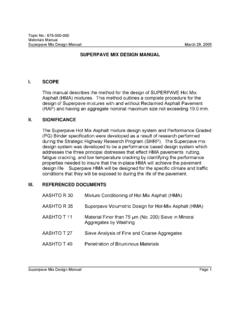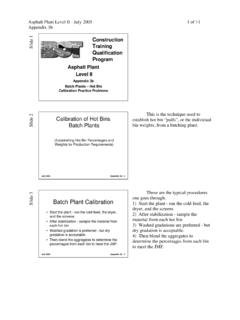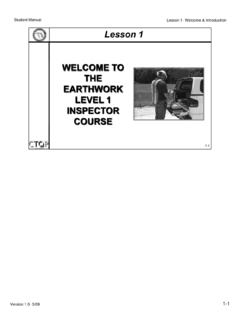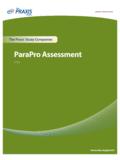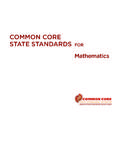Transcription of FLORIDA DEPARTMENT OF TRANSPORTATION - …
1 CONSTRUCTION MATH a training course developed by the FLORIDA DEPARTMENT OF TRANSPORTATION This 2002 revision was carried out under the direction of Douglas Townes, , State Construction Training Engineer FLORIDA DEPARTMENT of TRANSPORTATION Douglas Townes, State Construction Training Engineer Yvonne Collins, State Construction Training Coordinator CONSTRUCTION MATH CONTENTS Chapter One: BASIC CALCULATING 1-1 Chapter Two: ROUNDING 2-1 QUIZ: CHAPTERS ONE AND TWO 2-14 Chapter Three: SYMBOLS - SQUARES - CUBES - EQUATIONS - FORMULAS 3-1 Chapter Four: UNITS OF MEASUREMENT 4-1 Chapter Five: AVERAGES - PERCENTS - RATIOS - PROPORTIONS 5-1 QUIZ: CHAPTERS THREE, FOUR AND FIVE 5-28 Chapter Six: CALCULATING AREAS 6-1 Chapter Seven: CALCULATING VOLUMES 7-1 Chapter Eight: HIGHWAY PROBLEMS 8-1 Chapter Nine: REVIEW QUIIZ 9-1 i DIRECTIONS TO COURSE USERS INTRODUCTION This is Construction Math -- a course of training in basic mathematics for highway inspection personnel.
2 It can also be used by materials testing, design and other technical employees. TRAINING TECHNIQUE Construction Math has been designed for self-instructional training: You can work alone. You can make as many mistakes as are necessary for learning -- and correct your own mistakes. You can finish the training at your own speed. Some space has been provided for you to make calculations in this book -- but use a scratch pad too. You will then be able to work faster, make mistakes without a lot of erasing, and make up and solve problems of your own. You will keep this book as your personal copy, so work neatly any problems you may want to use for reference. ii iii EXAMINATION An examination has been developed for Construction Math. It contains questions and problems only -- no answers .
3 So that you can prepare yourself properly for that examination, Construction Math contains quizzes and highway problems. If you can handle the quizzes and highway problems in Construction Math, you will have no difficulty with the examination. INSTRUCTIONS This is not an ordinary book. You can't read it from page to page as you do other books. Most chapters begin with STARTING POINTS FOR TRAINING. If you already know how to make certain calculations you will be advised to skip the respective training sections. The answers to all problems follow their respective chapter. Go on to Chapter One. CHAPTER ONE Basic Calculating CONTENTS ADDITION 1-4 SUBTRACTION 1-12 CHECKING ADDITION -- SUBTRACTION 1-15 MULTIPLICATION AND DIVISION 1-17 CHECKING MULTIPLICATION AND DIVISION 1-31 HIGHWAY PROBLEMS 1-35 answers TO PROBLEMS 1-39 1-1 1 BASIC CALCULATING This chapter has been written to provide a review-- a brief retraining in adding, subtracting, multiplying and dividing.
4 It covers both whole and decimal numbers. Much of the training involves things you have known before, and probably know now. Other discussions will make clear things you have misunderstood about basic calculations. Experience with persons who have taken this training indicates that you should review this chapter -- even if you need little practice in the basic calculations. STARTING POINTS FOR TRAINING Different persons need to start their training in different places. Work the following problems. 1-2 PROBLEMS 1. = _____ 2. = _____ Right? Work the "HIGHWAY PROBLEMS" on page 1-35. If you have difficulty with those problems, study the appropriate sections in this chapter.
5 Wrong? Try Problems 3 and 4. 3. x = _____ 4. x = _____ Right? Fine! You can skip to the section titled "DIVIDING WHOLE AND DECIMAL NUMBERS" on page 1-24. If you would rather review "BASIC CALCULATING," scan the earlier sections. Wrong? Work Problems 5 and 6. 5. 4151 - = _____ 6. - = _____ Right? Start with "MULTIPLICATION AND DIVISION" on page 1-17. Review "ADDITION" and "SUBTRACTION" if you like. Wrong? Try Problems 7 and 8. 7. + = _____ 8. + _____ Right? Start studying "SUBTRACTION," page 1-12. You probably should study "ADDITION" for a quick review. 1-3 ADDITION ADDING WHOLE NUMBERS You probably will remember everything about adding whole numbers -- but let's see.
6 Add these numbers: 26, 70, 2 and 36. 26 70 2 + 36 One -- Set the problem up -- like this: -- Line up your columns from the right. 26 70 2 + 36 4 Add down Two -- Start at the top of the right column and add down. -- In this case, 6 + 2 + 6 = 14 Three -- Write 4 below the column you added, as shown above. -- Write 1 above the next column, as shown below. -- The "1" is a "carry digit." It is "carried" from the answer in the first column and added with the digits in the second column. Carry digit 26 70 2 + 36 1341 Four -- Add the second column and write the answer in the answer space as shown. -- In this case, the digits 1, 2, 7 and 3 add to 13 1-4 PROBLEMS 9.
7 Add the following whole numbers: 3 + 31 + 430 + 27 = _____ 10. Add the following whole numbers: 11 + 273 + 200 + 35 = _____ Right? On both problems? Study "ADDING DECIMAL NUMBERS." Get one wrong -- or both? Study "Discussion on Problems 9 and 10" on the next page. 1-5 Discussion on Problems 9 and 10 You made a mistake in Problem 9 or Problem 10 -- or both. Let's look at them in more detail. - Did you line up your columns from left to right? 3 31 430 27 11 273 200 35 - Make sure the right-hand column is straight. - Make all other columns just as straight. - Did you add the right columns first? 3 1 0 7 1 3 0 5 911 - Ignore the other columns while doing this step.
8 - Pretend they are not there. - Did you get "11" when you added 3,1 and 7? Did you get "9" when you added 1, 3 and 5? If not you just made a mistake adding. You will learn how to check addition later in this chapter. - Did you place the right-hand digits in your answer space, and the left-hand digit above the next column? (In the second problem, you only have a right-hand digit. Place a zero up there if you like.) 1-6 Discussion on Problems 9 and 10,continued 3 31 430 27 1 200 35 9 11 273 1 0 Add the next column Ignore the rest - Did you get "9" when you added 1, 3, 3 and 2? Did you get "11" when you added 0, 1, 7, 0 and 3?
9 If not, look at these columns again. 1100 3 31 430 27 91 11 273 200 35 19 - Did you place the right-hand digits in your new answers below the second columns and use the left-hand digits as carry digits? - Did you add the third columns? If not, do it now. 1 3 31 430 27 491 10 11 273 200 35 519 00 + 4 = 4. Place 4 in the answer space. 1 + 2 + 2 = 5. Place 5 in the answer space. - Your final work should look like this: Now, try Problems 11 and 12. 1-7 PROBLEMS 11. 17 + 22 + 347 + 9 = _____ 12. 151 + 9 + 70 + 2411 = _____ Calculations. Problems 11 and 12 1 151 1 9 70 + 2411 2641 17 2 0 22 347 + 9 395 Right?
10 You knew it all the time? Wrong? You will find your problem as you go on with the training. Study "ADDING DECIMAL NUMBERS". ADDING DECIMAL NUMBERS Adding decimal numbers is the same as adding whole numbers -- except that you have to watch the decimal points. Decimal numbers are lined up by the decimal points. The decimal points must form vertical lines. , , , and should be lined up as shown below: Like this: Not like this: Nor like this: Vertical Line 1-8 Place the number having the most decimal places at the TOP of the column. Attach zeros to make each number have the same number of decimal places as the top one.

